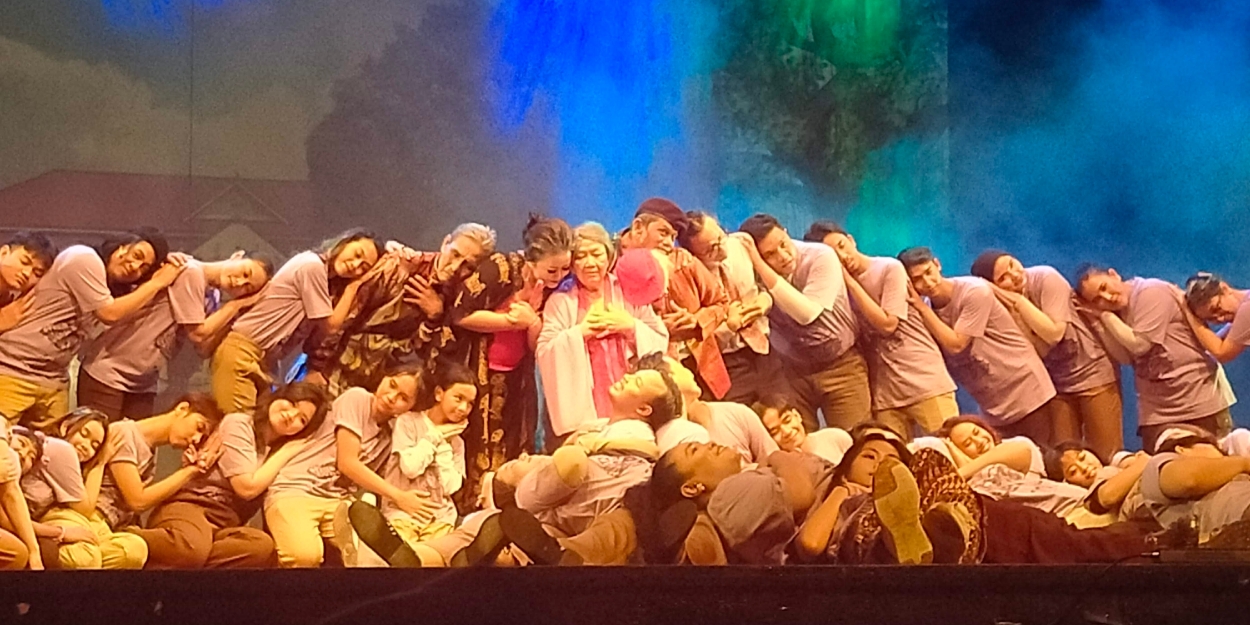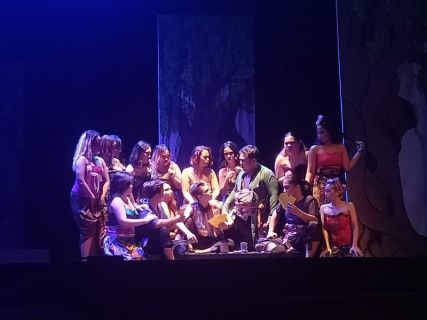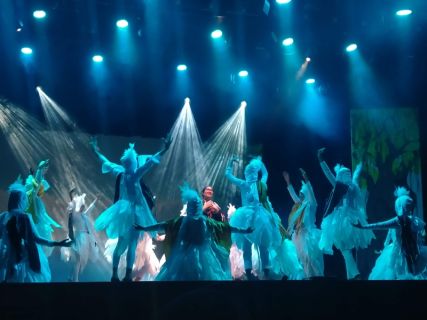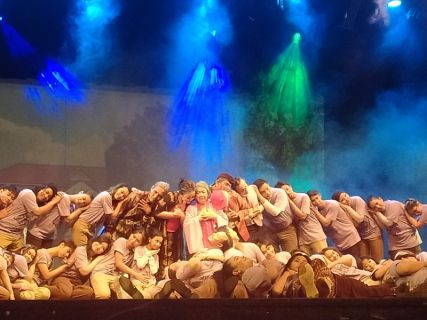Review: Teater Keliling Celebrates 50th Anniversary with the Psychedelic Musikal Mega Mega
This adaptation of Arifin C’ Noer’s 1967 script ran for two days on February 24th and 25th.

On February 24th and 25th, Teater Keliling celebrated their 50th anniversary by putting on a production of Musikal Mega Mega at Gedung Kesenian Jakarta. The show is based on the non-musical play Mega-Mega by writer and director Arifin C. Noer. This musical adaptation was directed by Rudolf Puspa, with original music by Rudolf Puspa and Dolfry Inda Suri.
Teater Keliling was founded on February 13, 1975 by Ir. Dery Syrna, Rudolf Puspa, Buyung Zasdar, and Paul Pengemanan. They have produced more than 1700 theatrical shows, bringing their shows on the road to all the provinces in Indonesia and 12 countries on 4 continents. In 2010, MURI (the national record museum of Indonesia) granted them the title of the theatre group with the most modern Indonesian theatre productions.
This production made several changes to the 1967 script, other than the addition of the musical bits. There were additional scenes, which made the runtime unwieldy at around 3,5 hours without intermission. This made it difficult to focus on the show’s latter parts, due to physical and mental fatigue.

The show opens with a group of elders, played by Teater Keliling veterans (including director Rudolf Puspa) reminiscing in front of a great banyan tree. The scene then transitions to the past, into a scene of a bustling market. Merchants are peddling their goods, gamblers are betting away what meager money they have, and a group of loud, excited prostitutes are calling for clients.
This scene is clearly intended as a comedic improv bit with some audience interaction; the prostitutes would call out to the audience and even point out specific members of the audience, commenting on their appearance or perceived wealth. Unfortunately, this goes on for a bit too long, and some quips rely on calling the audience member ‘poor’, which can get uncomfortable.
After the very long opening, we are introduced to the main cast: a group of homeless people living under a banyan tree. The oldest of them is a woman who goes by Ma’e (Grta A. Mulyosantoso and Jeje Bahri), who considers herself responsible for their little ragtag bunch. Then there’s Retno (Kemilau Daniswara), a youthful prostitute whose appearance is as beautiful as her singing; Tukijan (Achmad Fadlan), a laborer at the market who wants to transmigrate with Retno in the hopes of a better life; Panut (Boy Andrew), a thief looking for the next get-rich-quick scheme; Hamung (Rezky A. Nursaid), a laid-back man with a clubfoot; and Koyal (Raden Alwi Syahid), a young man who’s driven mad by his obsession of winning the lottery.

Mega-Mega doesn’t follow a straightforward plot; rather, it tells the hardships and joys of these marginalized people, especially during the era. It is a very timely piece, with transmigration (a program that moves landless people from densely populated cities to less developed areas around the country) being a major plot point
That being said, the biggest moment in the show is Koyal winning the lottery. Now a rich man, he invites his adoptive family to live in the lap of luxury; he takes them to the bank, to a shopping spree at the local department store, to indulge in a fancy dinner, culminating in them buying the Kingdom of Mataram. This scene is musicalized, making for a very extravagant number in which Koyal raps as he weaves his way between the lavishly costumed ensemble and changing set pieces.

Amidst these shameless displays of opulence, Ma’e finds herself walking on top of clouds before being brought down by the rest of them. Tired, everyone except for Koyal laid down to rest. Yet Koyal continues to dance merrily, drunk in his newfound wealth. Of course, it is revealed to be but a dream. Under the moon’s glow, Koyal’s ambition is given an ephemeral form. As he settles back to reality, however, Koyal sees the sleeping Retno and crept towards her legs. Tukijan sees this and fends him off, making him cry.
To get himself and Retno a better life, Tukijan is determined to join the transmigration program. However, Retno is reluctant. She wants to stay with Ma’e in her twilight years. Ma’e hears this and reassures Retno that she’d be happier to see her pursuing a better future than staying home for her sake. The two bid goodbye as the train takes Tukijan and Retno far, far away.
Although the original play ends shortly after this farewell, Musikal Mega-Mega adds an epilogue. The group of old people who appear in the very first scene is revealed to be the family of homeless people, now reunited: Ma’e (Dery Syrna), Koyal (Rudolf Puspa), Panut (Aditya Jaya), Tukijan (Hermansyah Nasution and Dwi Librianto), Hamung (Buyung Bizard), and Retno (karina Fajar Wijaya and Nadia Hendrajanto). All the children have found better lives and once again gather around their mother, Ma’e, under the canopy of the banyan tree.

Mega-Mega is a story that, at its heart, gives center stage to the struggles of marginalized people. It shows the contrasts of pursuing a better future through hard work (as exemplified by Tukijan looking to join the transmigration program) and simply gambling on a pipe dream (Koyal and his lottery tickets).
Conceptually, it’s a timely choice. The recent rise of online gambling in Indonesia has been devastating to the most vulnerable people, and it’s easy to draw comparisons to Koyal’s ceaseless gambling addiction. Unfortunately, this message gets a bit lost between everything else that’s happening in the story. The addition of additional scenes also murked things up, and it’s easy to get lost when the show goes on a long tangent about the prostitutes or a gang of thieves that doesn’t really play into the main story.

Additionally, the script also shows its age. There are a lot of terms that can be seen as queerphobic or body shaming by the modern audience. The prostitutes made jabs at Retno’s abortion. Of course, it doesn’t necessarily mean that the showrunners need to resort to puritan censorship, but since they are adapting a play into a musical and adding new scenes already, perhaps a more mindful approach to the script would be a net positive. At least, it would perhaps make those offending lines be less distracting and uncomfortable.
In an effort to modernize the show somewhat, the creatives added some contemporary references, mostly during the allocated comedic scenes. This mostly falls flat, as references are not a substitute for actual, good jokes. Moreover, there was at least one reference that’s actually 16 years old.
Due to its long running time, no intermission, aged script, and narratively empty comedic bits, the show can be hard to sit through. There are also moments of unfortunate mood whiplash, such as when a heartfelt, tender moment between Tukijan and Retno is immediately destroyed by whistles and shouts from the prostitutes.But making it a musical does help, as many of the musical numbers are vibrant and enjoyable. Of particular note is Koyal’s dream scene, a show-stopping number with dozens of dancers and kaleidoscopic scenery.
The cast’s committed performance also brought much-needed life and energy to the show. By the nature of the script, some characters get more substantial parts to dig into. Of particular note are Kemilau Daniswara’s Retno, whose heartful singing voice is a good fit to the character’s melancholic moments, and Raden Alwi Syahid’s Koyal, an animated performance that brings Koyal’s wide-eyed, yet ruinous optimism to the forefront.

Musikal Mega Mega’s artistic design is beautiful. The banyan tree that serves as the centerpiece in many scenes, has a lifelike grandeur to it. The costumes are a brilliant mix of traditional and contemporary fabrics in various modern cuts, making for creative, aesthetically pleasing pieces. The lighting is bold and dramatic, helping elevate the climactic scenes.
Taken altogether, Teater Keliling’s Musikal Mega Mega is a mix of good and bad. The script has potential for current-day relevancy as well as great musical numbers, but is weighed down by its uneven pacing and some badly aged lines and jokes. That being said, there is no denying that this production has its own charm.

Particularly, in the final scene, and the older Teater Keliling actors come on stage, it’s a beautiful testament to the long, celebrated legacy of Teater Keliling. And it's cute. For a moment, it doesn’t matter that this happy ending overrides the script’s more ambiguous, bittersweet ending. We are there to celebrate Teater Keliling’s momentous achievement.
There is always more to learn and discover, and Teater Kelilng’s wealth of experience is an inseparable and precious part of guiding the Indonesian theatre to the future. Happy 50th anniversary, Teater Keliling.
Reader Reviews

Videos

